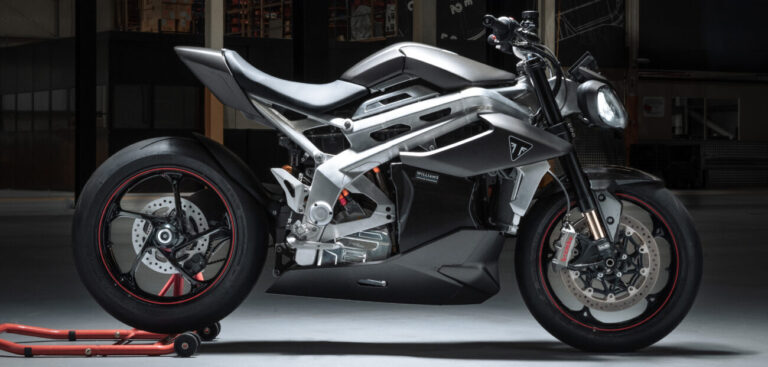The Project Triumph TE-1 electric motorcycle has been revealed in completed prototype form, the result of a collaboration between Triumph Motorcycles, Williams Advanced Engineering (WAE), Integral Powertrain and WMG at the University of Warwick.
Marking the official end of the collaboration stage of the TE-1 project, the completed demonstrator is now ready for the next Triumph-led stage of the project to begin – a comprehensive testing program.
Triumph was responsible for designing the final chassis, including frame, rear sub-frame, cockpit, panels and wheels, final drive system including transmission and Gates Carbon belt drive, as well as the chassis control software. WAE meanwhile developed the battery pack, rated at a peak output of 170kW and continuous power of 90kW, with a capacity of 15kWh. The 360V system also enables a fast-charging time of under 20mins (0-80%), which is combined with a market leading target range.
WAE says it optimized the battery module layout to balance mass and positioning within the prototype chassis taking into consideration center of gravity, space and relationship with the powertrain and charging approach.
Integral Powertrain was responsible for the powertrain, developing a motor said to achieve peak and continuous power densities of 13kW/kg and 9kW/kg respectively. Despite the impressive power density, Integral says the design was achieved using materials and processes compatible with volume automotive production and, importantly, using a length scalable motor platform. The motor is coupled with a SiC inverter with integrated cooling.
With the completion of the prototype demonstrator, the full live testing phase of the TE-1 project is set to begin (phase 4). Over the next six months, the prototype demonstrator will undertake an extensive live testing program within Triumph’s facilities, which will encompass:
Rolling road testing – core functional assessment to include:
- Throttle calibration;
- Powertrain performance mapping;
- Power and torque output;
- Range and battery consumption assessment;
- Rider mode development;
- Software functionality validation; and
- Thermal optimization.
Track testing – encompassing dynamic rider assessment to include:
- Handling;
- Acceleration;
- Braking and braking regeneration strategy;
- Traction control; and
- Front wheel lift control.
At the completion of the live testing phase, estimated to be summer 2022, the prototype demonstrator will be updated with its final body panels and paint scheme, in preparation for active track demonstration, and media engagement. At this time, the full results of the project including the final specifications and testing outcomes will be published.
“It has been truly exciting to see the progress made during phase 3 of Project Triumph TE‑1 with the final prototype motorcycle now going into real-life testing. Everyone involved at Triumph is proud to have been part of this innovative British collaboration. Personally, I am thrilled with the results we have already achieved with our partners, and the exciting preview of the potential electric future to come,” said Nick Bloor, Triumph CEO.
“We look forward to continuing the ambitious and innovative work on the TE-1 demonstrator prototype through the live testing phase and sharing the outcome with Triumph fans across the world.”


